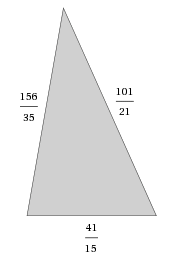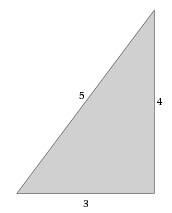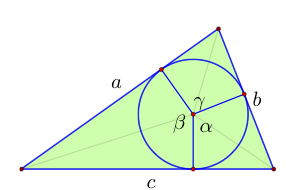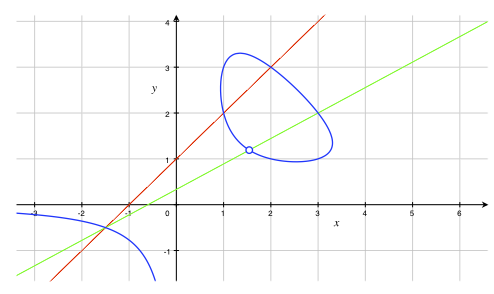Heron Triangles and Elliptic Curves: Unterschied zwischen den Versionen
(→A curve of triangles with constant area and perimeter) |
(→A curve of triangles with constant area and perimeter) |
||
| Zeile 155: | Zeile 155: | ||
and <math>(3, 1)</math> all correspond to the triangle with sides <math>3</math>, <math>4</math>, and | and <math>(3, 1)</math> all correspond to the triangle with sides <math>3</math>, <math>4</math>, and | ||
<math>5</math>, with the sides taken in different orders. | <math>5</math>, with the sides taken in different orders. | ||
| + | |||
| + | <ggb_applet width="694" height="463" version="4.0" ggbBase64="UEsDBBQACAAIAH1WaD8AAAAAAAAAAAAAAAAWAAAAZ2VvZ2VicmFfamF2YXNjcmlwdC5qc0srzUsuyczPU0hPT/LP88zLLNHQVKiuBQBQSwcI1je9uRkAAAAXAAAAUEsDBBQACAAIAH1WaD8AAAAAAAAAAAAAAAAMAAAAZ2VvZ2VicmEueG1svVjrb9s2EP/c/hUHfUq22BZF6uHCbtEWGFag7QqkK4YVHUBJtM1aEgU9HLnoH78jKcmPpEXWBgvi8HXkPX935yyedXkGO1HVUhVLh0xdB0SRqFQW66XTNqtJ5Dx7+nixFmot4orDSlU5b5YO05QyXToRD5OEpcEkWMXJhDEeTXjizydRsuJxzOZhxDwHoKvlk0K95bmoS56I62Qjcv5aJbwxjDdNUz6ZzW5ubqYDq6mq1rP1Op52deoAilnUS6efPMHnTi7dUEPuuS6Z/fXmtX1+Iou64UUiHNAqtPLp40eLG1mk6gZuZNpslk5IUI2NkOsN6hS4uJhpohINUoqkkTtR49WjpdG5yUvHkPFCnz+yM8hGdRxI5U6molo67pSygIVRFFKPzhkNAgdUJUXR9LSk5zkbXlvspLixz+qZ4cgcaJTKYq5fhK9fwXM9F670QOzg4RAE9si1ey61g2cHZgff0jB7nVlSZmmYpWHUgZ2sZZyJpbPiWY0WlMWqQu+N67rZZ8LI028ctCdXqFMtvyAx1Sa1Jsd9173SH7TzFRtsfaQkOeLaVO1/ZDqwDObs/iy9n1KUDjw9Ftzm6fnfUDP4DlOr9330JP6RaZGV+TWfWxzp99Q852jXP8cwYP+LiovZAJVFjw6oN5q2j55G5LXGC52DP9dhT8BHbAQhRrkPZI5D6AGiAYgPzMcliSDQYwg0xAMGFCLQdISCAYcf4R8WmscC8PExvRsiJoEgIwY+BWIwxQCRBAaXiFGPIoXvg4+XNHvi6SdoACzAFY2AoYwakiFBQooXcY3sPaAEqL5MQvACCPR7hGmoB5EWHZ/0IHAhIPpBRDUi2qIZ6SOgWpugN5csyrY5MVGSp8O0UeXoC6TGfHTIejY/nSTFR4uMxyLDOnGtPQmw45lGhGG0UkUDgxM9u7eueLmRSX0tmgZv1fCZ7/hr3ojuN6SuB96GNlFF/a5SzUuVtXlRAyQqc0eZVUaO5t4oNS7o0QE7PvCPDoKjeXgnX4Un0NYC+auqHsh5mr7SFIfUgJb8o8j2LyrBt6WSp2osZqbkLESbZDKVvPiAwaq5aLvAUIFMuhoqEKP+IIiq0ut9jREM3d+iUphjiD91j38w++ztESXk9AgdXidcg893T08QW/tvHhnWYjd6iHdiVH5daWD3iuvFq/qFyg5bRv2XvGzayvQOKF2llXperDNhQsQAGwtzso1Vd21jg9q33u9LXLlWgHhtzA6YGjzfR4J+jO1oaLRkI5VraFxD4Q7BJtPxnMw9Q2HG2I6GCqPXitZrSgY1iTuwkbVJaK5zAhsT+rrMt4VsXg+LRibbg6aa/m2bx2IMoNMnyQM9uZidBdhiK6pCZH08oydb1dYWnkehnopE5ri0B71BuHbWnyiA3U3FuhKD3Jnpyqy5zKl7HKq3ts1Tv1Uqf1Xs3mMknAmwmA1SLuqkkqUOOIixBmzFIaZSWXMsIenxPQ1AVD3RpQLN02jTIDTbZqMq03hhRsFR4y4TObZZ0JjgKtpcVDIZDb01HRwK1fZyB9M+trSVQcWfMdWdOefgRTz+RvgBz8oN131fj6eM70V1Yhrz2huV9ox7ujrTDSPksjDP5LwzcQg8rjELNtgyoy+KQ8tsJeuzCPYbuiHvTCuiZ3vszM3WSnZizPFoI/kFY4KfKHOAQYMJeotdaG06o6ZHpZn8LtNUFKO0vMDoMT7AHFVadQHLg7CRPV4tUX2TD4483ztGu6grK+Smn+lNvMLvH50uRE+g++fCu4RfYA+/QqdHs17CFudmDRPYDqxkXmYykc07le1t/Tp1/3BemvOR2UP6272nv/tdLC/VcUHuYx5J5OivH3ZPosRqhfqiAWqotIN4VfG9gQcK+/EjRvsViqw/n64+6tlEb5FxSfrDT303cHBaovKcFykUppt7p/O+c+guuKvtao3WNsPOc+v5/uot75jiMZr9+Q+5hXi2VpixrxU/7Jzz8L4juMldwd2nw1ojkU49FrqhS6LIn3thSEMDS2/KvAh3WRDO597cR09+sd+87VdPbQpdHU8aKrt7lmS/jyTeI6m7eH6JCNrjcBcwzvMiP8+L/jQI/TAkgR/4kR+OJfjeKfB7YsLSWfdyri+6K9hrgF9MLjot8eUlzOCCIMwN3C+d29Kv2sJUgrcfeDWqsP5pWJ/Gjuc/ePD8QGaMezvtrT/RXDi5Mn69l2Pjc8difPoeRmBECKPUDckD+nXpJAe3HuTUmfyecZici8umKCJK61PPpV40pz8h7uy4izCdev9Pp6f/AlBLBwgBfmJErwYAABETAABQSwECFAAUAAgACAB9Vmg/1je9uRkAAAAXAAAAFgAAAAAAAAAAAAAAAAAAAAAAZ2VvZ2VicmFfamF2YXNjcmlwdC5qc1BLAQIUABQACAAIAH1WaD8BfmJErwYAABETAAAMAAAAAAAAAAAAAAAAAF0AAABnZW9nZWJyYS54bWxQSwUGAAAAAAIAAgB+AAAARgcAAAAA" framePossible = "false" showResetIcon = "false" showAnimationButton = "true" enableRightClick = "false" errorDialogsActive = "true" enableLabelDrags = "false" showMenuBar = "false" showToolBar = "false" showToolBarHelp = "false" showAlgebraInput = "false" useBrowserForJS = "true" allowRescaling = "true" /> | ||
===Finding points on the curve=== | ===Finding points on the curve=== | ||
Version vom 8. November 2011, 19:54 Uhr
Inhaltsverzeichnis |
A tale of two triangles
The following question arose in a group of teachers and mathematicians working for the Focus on Math project. If two triangles have the same area and the same perimeter, are they necessarily congruent? It turns out that the answer is no. For example, the triangle with sides 3, 4, and 5 has the same area and perimeter as the triangle with sides 41/15, 101/21, and 156/35.
Indeed, the perimeter is

The triangle with sides 3, 4, and 5, shown on the right, has area  . To find the area of the triangle on the left, we use
Heron's formula, which states that the area
. To find the area of the triangle on the left, we use
Heron's formula, which states that the area  of a triangle with
side lengths
of a triangle with
side lengths  ,
,  , and
, and  , is given by
, is given by

where  is the semiperimeter of the triangle.
A
quick calculation using this formula shows that the area of the
triangle on the left is also 6.
is the semiperimeter of the triangle.
A
quick calculation using this formula shows that the area of the
triangle on the left is also 6.
Note
For a description of how the teachers and mathematicians in Focus on Math worked on the this question see Steven Rosenberg, Michael Spillane, and Daniel~B. Wulf, Delving deeper: Heron triangles and moduli spaces, Mathematics Teacher 101 (2008), no.~9, 656.
The space of triangles
How do we find examples like this? The secret is to find the right way
of representing the space of all triangles. There are many possible
ways to do this. For example, we could think of the space of triangles
as the subspace of all triples  corresponding
to the three sides of the triangle. Not every point in
corresponding
to the three sides of the triangle. Not every point in  corresponds to a triangle; for example, all the coordinates must be
positive. Can you think of other restrictions?
corresponds to a triangle; for example, all the coordinates must be
positive. Can you think of other restrictions?
There's another way of putting coordinates on the space of triangles
using angles instead of lengths. Every triangle has an inscribed
circle, and the radius  of the circle has a simple relationship with
the area
of the circle has a simple relationship with
the area  and semiperimeter
and semiperimeter  , namely
, namely

To see why this is true, drop perpendiculars from the center of the circle to the sides of the triangle, as in Figure 1. These perpendiculars form the altitudes of 3 smaller triangles with bases on the sides of of the big triangle and and vertices at the center of the inscribed circle. Adding up the areas of these triangles we get equation (1).
Equation (1) tells us that if two triangles have the same area and same semiperimeter, then the radii of their inscribed circles are also the same. So if we are looking for two such triangles we will find them in the space of all triangles inscribed around a fixed circle. Instead of using lengths to parameterize this space, we will use the angles formed by the three radii at the center of incircle, as in in Figure 1.
A curve of triangles with constant area and perimeter
Inside this space we can find curves corresponding to a whole family
of triangles with the same values of  and
and  .
.
First, we express  in terms of the angles
in terms of the angles  ,
,  , and
, and
 and the radius
and the radius  of the incircle, as follows. The radii and the lines from the vertices
to the incenter break the triangle into six right triangles. Because
the lines from the vertices to the center bisect the angles of the big
triangle, these right triangles occur in congruent pairs. Taking one
base length from each pair and adding , we get
of the incircle, as follows. The radii and the lines from the vertices
to the incenter break the triangle into six right triangles. Because
the lines from the vertices to the center bisect the angles of the big
triangle, these right triangles occur in congruent pairs. Taking one
base length from each pair and adding , we get

Equations (1) and (2) together
tell us that if the area  and semiperimeter
and semiperimeter  are constant, then
so is the sum of the tangents:
are constant, then
so is the sum of the tangents:

Second, we translate this condition into an equation defining a curve
in the plane. Let  ,
,  , and
, and  .
Since
.
Since  , we have
, we have

so

Then, if  is the constant
is the constant  ,
equation (3) becomes
for fixed
,
equation (3) becomes
for fixed  , the equation
, the equation

which we rewrite as

Every triangle with area  and semiperimeter
and semiperimeter  determines a
point on this curve, and every point on the curve in a certain region
of the plane corresponds to a triangle. The
region corresponds to angles that actually work in
Figure 1, namely angles satisfying
determines a
point on this curve, and every point on the curve in a certain region
of the plane corresponds to a triangle. The
region corresponds to angles that actually work in
Figure 1, namely angles satisfying
 and
and  , which
corresponds to the region
, which
corresponds to the region  ,
,  and
and  (since
(since  ).
).
Figure 2 shows this curve for  , the
value corresponding to the triangle with sides 3, 4, and 5. Every
point on the component of this curve in the positive quadrant
corresponds to a triangle; the side lengths of the triangle are
, the
value corresponding to the triangle with sides 3, 4, and 5. Every
point on the component of this curve in the positive quadrant
corresponds to a triangle; the side lengths of the triangle are  ,
,  , and
, and  . In particular, the points
. In particular, the points
 ,
,  ,
,  ,
,  ,
,  ,
and
,
and  all correspond to the triangle with sides
all correspond to the triangle with sides  ,
,  , and
, and
 , with the sides taken in different orders.
, with the sides taken in different orders.
Finding points on the curve
Because the curve in Figure 2 is defined by an
equation of degree 3, we can find points on it using the secant
method. Two points on the curve determine a secant which cuts the
curve in one more point; finding the point amounts to solving a cubic
equation in  , two of whose roots are already known. Since we
already have 6 points on the curve, there are lots of possibilities
for secants, and generating more points generates more
possibilities. In fact, the curve has infinitely many points with
rational coordinates. The two-secant procedure illustrated in
Figure 2 leads to the point
, two of whose roots are already known. Since we
already have 6 points on the curve, there are lots of possibilities
for secants, and generating more points generates more
possibilities. In fact, the curve has infinitely many points with
rational coordinates. The two-secant procedure illustrated in
Figure 2 leads to the point  (marked with a circle), which corresponds to the triangle with sides
(marked with a circle), which corresponds to the triangle with sides
 ,
,  , and
, and  .
.
The secant procedure works for any cubic curve in the plane; such curves are called elliptic curves (not because the curves are themselves ellipses, but because they arise in the study of a certain class of complex functions called elliptic functions). The secant procedure allows one to define a group structure on the set of rational points on a elliptic curves (that is, points whose coordinates are rational numbers).
The mathematical moral
The study of elliptic curves is a central area of research in number theory, with applications to the cryptographic schemes behind secure financial transactions on the web. Elliptic curves played a central role in the proof of Fermat's Last Theorem.
The story described in this article shows the remarkable unity of mathematics, starting as it does in high school and ending in research. Along the way we encountered a fundamental idea in modern mathematics: the idea of solving a problem about a particular type of object (triangles with area 6 and perimeter 12, for example) by situating the object in a more general space (the space of all triangles) and finding the right way of parameterizing that space.





